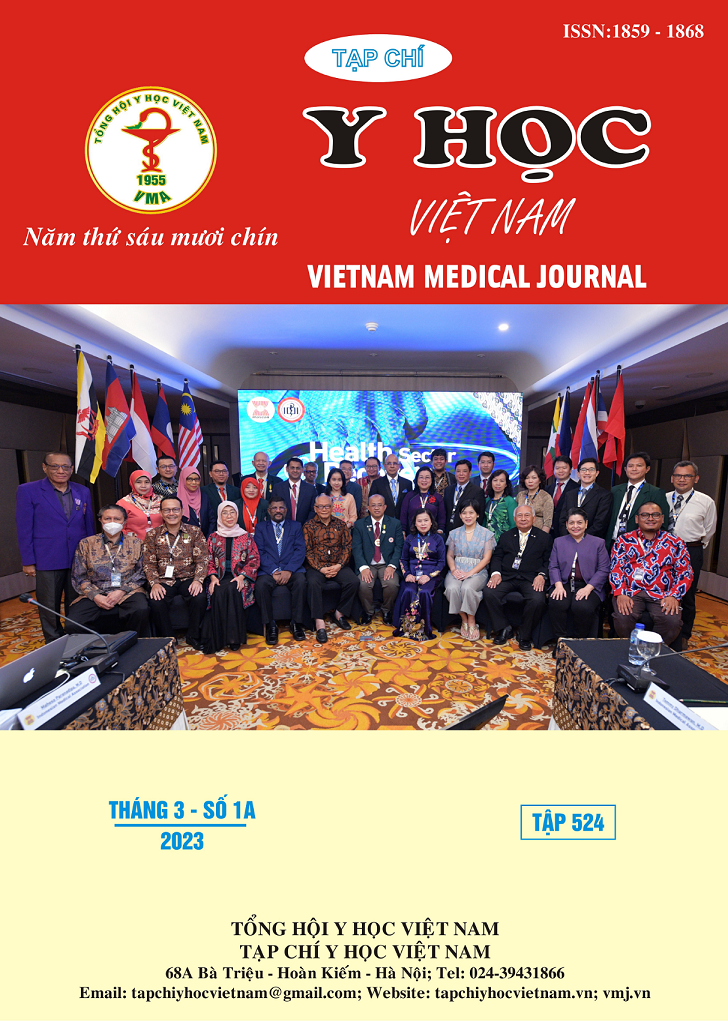THE RESULTS OF MINI PERCUTANEOUS NEPHROLITHOTOMY UNDER ULTRASOUND GUIDANCE FOR TREATMENT OF KIDNEY STONES AT THAI NGUYEN GENERAL HOSPITAL
Main Article Content
Abstract
Objective: To evaluate the results of mini percutaneous nephrolithotomy under ultrasound guidance for treatment of kidney stones at Thai Nguyen general hospital. Patients and methods: Cross-sectional description of 139 patients have been operated by mini percutaneous nephrolithotomy under ultrasound guidance for treatment of kidney stones at Thai Nguyen general hospital from January 2020 to May 2022. The patients have assessed and collected characteristics, the collected date is processed on the system statistics SPSS 25.0 software program. Results: The average age is 52,99 ± 11,64 years. Mean stone size was 28,96 ± 10,61 mm, stone size over 30mm was 43,9%. The number of stones over 1 was 66,2%. Stones in renal pelvis-calyx were 80,6% (112/139 patients); 60,4% patients were GSS grade III and IV. The stone free rate after the first operating was 53,2%; 20,9% patients were performed the second operating and the stone free rate after 1 month was 63,3%. The rate of complications was 15,1%, including 10,1% fever post-operative; 0,7% bleeding without transfusion; 2,9% bleeding with transfusion; 7,1% seroma around kidney; 0,7% angioembolization due to kidney artery injury; 0,7% spleen injury; 0,7% septic shock. Overall outcome after mini-PCNL: Good 59,7%; average 40,3% and bad 0%. Conclusion: Mini percutaneous nephrolithotomy under ultrasound guidance for treatment of kidney stones is the efficacy, safety methods.
Article Details
Keywords
Kidney stone, mini percutaneous nephrolithotomy.
References
2. Lê Đình Nguyên (2021), "Nghiên cứu kết quả điều trị sỏi thận có kích thước lớn hơn 2 cm bằng phương pháp lấy sỏi qua da", Luận án Tiến sĩ y học, Học viện Quân y.
3. Nguyễn Minh An, Đặng Văn Hùng (2021), "Đánh giá kết quả điều trị sỏi thận san hô bằng phương pháp tán sỏi qua da đường hầm nhỏ tại Bệnh viện đa khoa tỉnh Hải Dương năm 2020", Tạp chí Y học Việt Nam, 503 (2), pp. 66-70.
4. Nguyễn Nhật An, Lê Ánh Nguyệt, Cao Quyết Thắng, và cộng sự (2022), "Đánh giá kết quả tán sỏi thận qua da bằng đường hầm nhỏ điều trị sỏi san hô tại Bệnh viện quân y 103", Tạp chí Y học Việt Nam, 519 - Tháng 10 - Số chuyên đề, pp. 3-10.
5. Jiang H, Yu Z, Chen L, et al (2017), "Minimally Invasive Percutaneous Nephrolithotomy versus Retrograde Intrarenal Surgery for Upper Urinary Stones: A Systematic Review and Meta-Analysis", Biomed Res Int, 2017.
6. Moreno-Palacios J, Avilés-Ibarra O J, García-Peña E, et al (2018), "Rearrangement of the Guy's stone score improves prediction of stone-free rate after percutaneous nephrolithotomy", Turk J Urol, 44 (1), pp. 36-41.
7. Temel M C, Ediz C, Okçelik S, et al (2020), "Perioperative indices predicting fever following percutaneous nephrolithotomy", J Coll Physicians Surg Pak, 30 (12), pp. 1306-1311.


